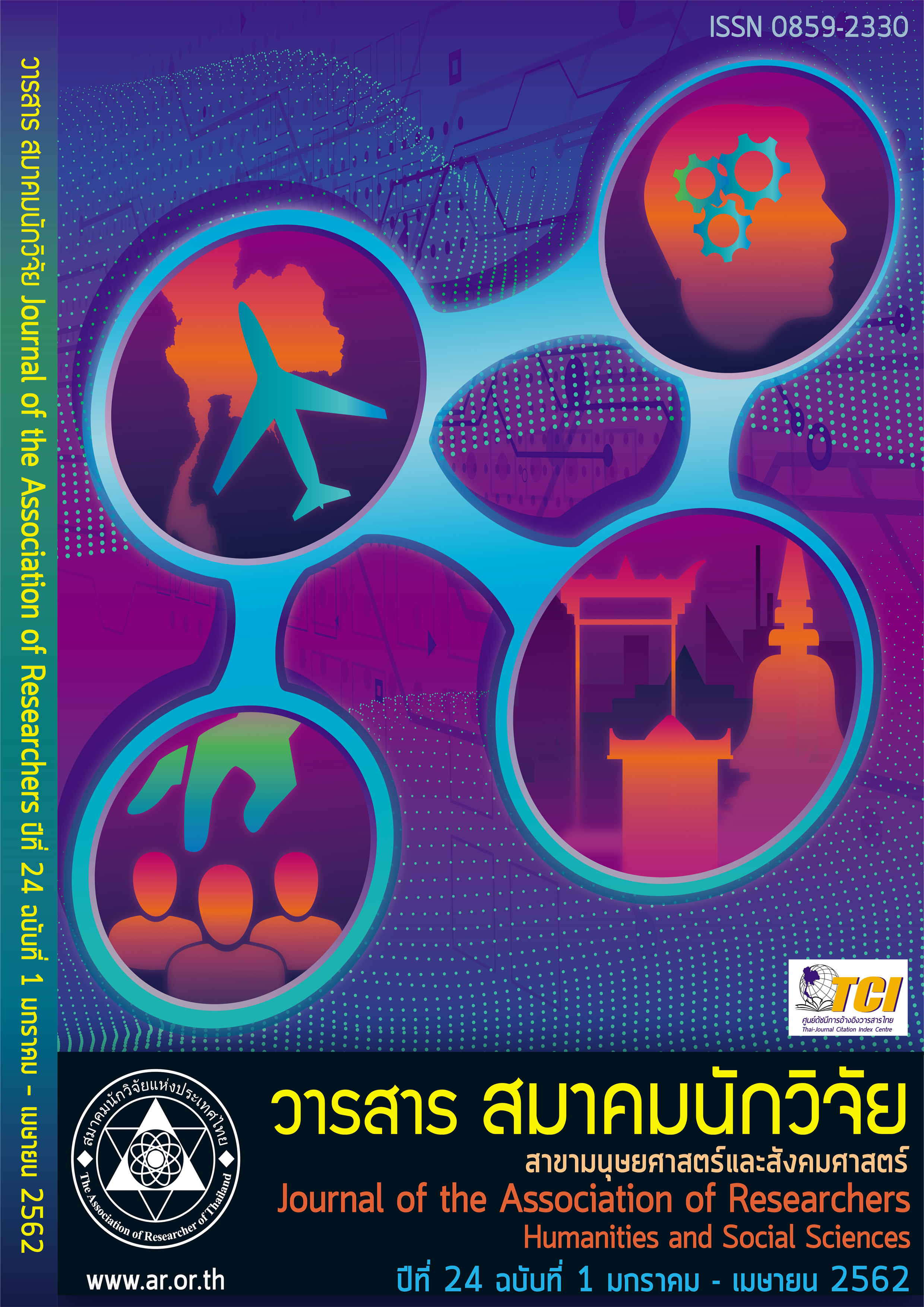The Thai Handicraft Bangkok Vicinities and Phrae Province
Main Article Content
Abstract
This research is to collect and study gingerbread fretworks of artisan clans in Bangkok, vicinities and Phrae Province. The research is a consequence of the study on Gingerbread House Architecture in Thailand, Case Study: Bangkok, Vicinities and Phrae Province. The objectives of this research are to study buildings decorated by fretworks and collect, copy, analyze and categorize gingerbread designs found in Bangkok, Vicinities and Phrae Province, so that the local art and culture in central and northern regions can be preserved before they are demolished or deteriorated. The study can be used as learning and teaching materials for architecture or building improvement and decoration and so on. This study uses data received from the study result of Gingerbread House Architecture in Thailand, Case Study: Bangkok, Vicinities and Phrae Province as a main field of study in actual places. The places include 12 buildings decorated by gingerbread fretworks with 156 designs. According to the study, the buildings decorated with gingerbread fretwork were popular during the reigns of King Rama V and King Rama VI. However, the popularity decreased during the reign of King Rama VII. Most of the buildings are located in Phra Nakhon District of Bangkok, Mueang District of Nakhon Pathom Province and Mueang District of Phrae Province. These buildings were influenced by Western culture before the influence spread to Bangkok. For the buildings decorated by gingerbread designs, there is no information about the artisans. However, the only information shows that most of the artisans were local and Chinese artisans. Meanwhile, some fretworks were purchased from the capital city. The buildings were popularly decorated by gingerbread designs. The decorations were in the areas beyond accordion doors, windows and supporters. Also, the decorations were beneath ceilings, eaves ornamental fringes, splashboard ornamental fringes, window ornamental fringes, balustrade bars and splashboard skids. Gingerbread designs includewood patterns, and most of the wood patterns are vertical, horizontal, transparent, delicate, curved and smooth. In addition, some patterns are twisted. The uniqueness of the pattern is vine pattern by having branches, clusters and glumes. Meanwhile, tulip pattern is the original pattern of gingerbread design. Another characteristic is a pattern derived from gaps, and most of them are vertical by being perforated into a variety of closed and opened gaps linked with the same style of perforated wood plates. The pattern of perforated gaps is caused from wood with two opened gaps by similarly having left and right perforations. Additionally, the left perforation is different, or it is on single wood plates consistently placed in array. The popular patterns of perforated gaps include larvae, leaves, flowers and petals. After the patterns are produced, the patterns will possess the same characteristics as those of a variety of clusters.
Article Details
บทความที่ปรากฏในวารสารนี้ เป็นความรับผิดชอบของผู้เขียน ซึ่งสมาคมนักวิจัยไม่จำเป็นต้องเห็นด้วยเสมอไป การนำเสนอผลงานวิจัยและบทความในวารสารนี้ไปเผยแพร่สามารถกระทำได้ โดยระบุแหล่งอ้างอิงจาก "วารสารสมาคมนักวิจัย"
References
พระราชวชิรโมลี. เจ้าอาวาสวัดสวนพลู. (17 กุมภาพันธ์ 2561). สัมภาษณ์.
ภรดี พันธุภากร. (2547). การศึกษารวบรวมลวดลายไม้ฉลุแบบขนมปังขิง สกุลช่างจันทบุรี. ชลบุรี : กรมศิลป์การช่าง
ภัทราวดี ศิริวรรณ. (2559). การศึกษารูปแบบเรือนขนมปังขิงในประเทศไทย กรณีศึกษากรุงเทพฯ ปริมณฑล และจังหวัด แพร่. มหาวิทยาลัยเทคโนโลยีราชมงคลสุวรรณภูมิ นนทบุรี
ภาวินี ตรีชัยยุทธ์. เจ้าหน้าที่พระราชวังสนามจันทร์ จ.นครปฐม. (30 กันยายน 2560). สัมภาษณ์.
วรชยา จิโนรส. นักวิชาการศึกษา สำนักศิลปะวัฒนธรรม. มหาวิทยาลัยราชภัฏบ้านสมเด็จเจ้าพระยา. (19 มีนาคม 2561). สัมภาษณ์.
วรพล ภาโนมัย. เจ้าหน้าที่จิตอาสา คุ้มเจ้าหลวงเมืองแพร่. (23 พฤษภาคม 2561). สัมภาษณ์.
สหยศ วงศ์บุรี. เจ้าของบ้านวงศ์บุรี. (21 พฤษภาคม 2561). สัมภาษณ์.
สำนักพระราชวัง. (2555). พระที่นั่งวิมานเมฆ. กรุงเทพฯ : อมรินทร์พริ้นติ้งแอนด์พับลิชิ่ง จำกัด.
อุกฤษ มงคลนาวิน. ประธานมูลนิธิ ศ.ดร.อุกฤษ-ท่านผู้หญิงมณฑินี มงคลนาวิน (17 มีนาคม 2561). สัมภาษณ์.
Translated Thai Reference
Department of Archaeology, Fine Arts Department, Ministry of Culture. (2017). Gingerbread Fretwork, Aesthetics of Rattanakosin. Bangkok: Amarin Printing and Publishing Public Company Limited. (In Thai).
Paradee Panthupakorn. 2004. Study and Collection of Gingerbread Fretworks in Thailand, Chanthaburi Artisan Clan. Chon Buri: Department of Artisans (In Thai).
Patravadee Siriwan. (2016). Study of Gingerbread Patterns in Thailand, Case Study: Bangkok and Its Vicinity and Phrae Province. Rajamangala University of Technology Suvarnabhumi Nonthaburi Bureau of the Royal Household. 2012. Vimanmek Mansion. Bangkok: Amarin Printing and Publishing Company Limited. (In Thai).
Worapol Panomai, Volunteering Official of Khum Chao Luang Mueang Phrae. (May 23, 2018). Interview. (In Thai).
Sahayot Wongburi. Owner of Baan Wong Buri. (May 21, 2018). Interview. (In Thai).
Phra Ratchawachiramoli. Abbot of Suan Plu Temple. (February 17, 2018). Interview. (In Thai).
Worachaya Jinorot. Educationist, Office of Arts and Culture. Ban Somdet Chao Phraya Rajabhat University. (March 19, 2018). Interview. (In Thai).
Pawinee Trichaiyut. Official of Sanam Chan Palace, Nakhon Pathom Province. (September 30, 2017). Interview. (In Thai).
Ukrit Mongkolnavin. Chairperson of Prof. Dr. Ukrit-Thanpuying Monthinee Mongkolnavin Foundation (March 17, 2018). Interview. (In Thai).


